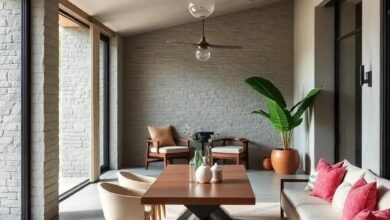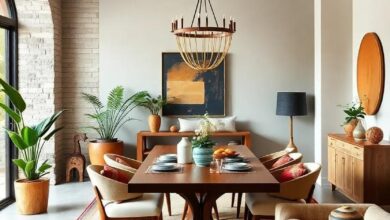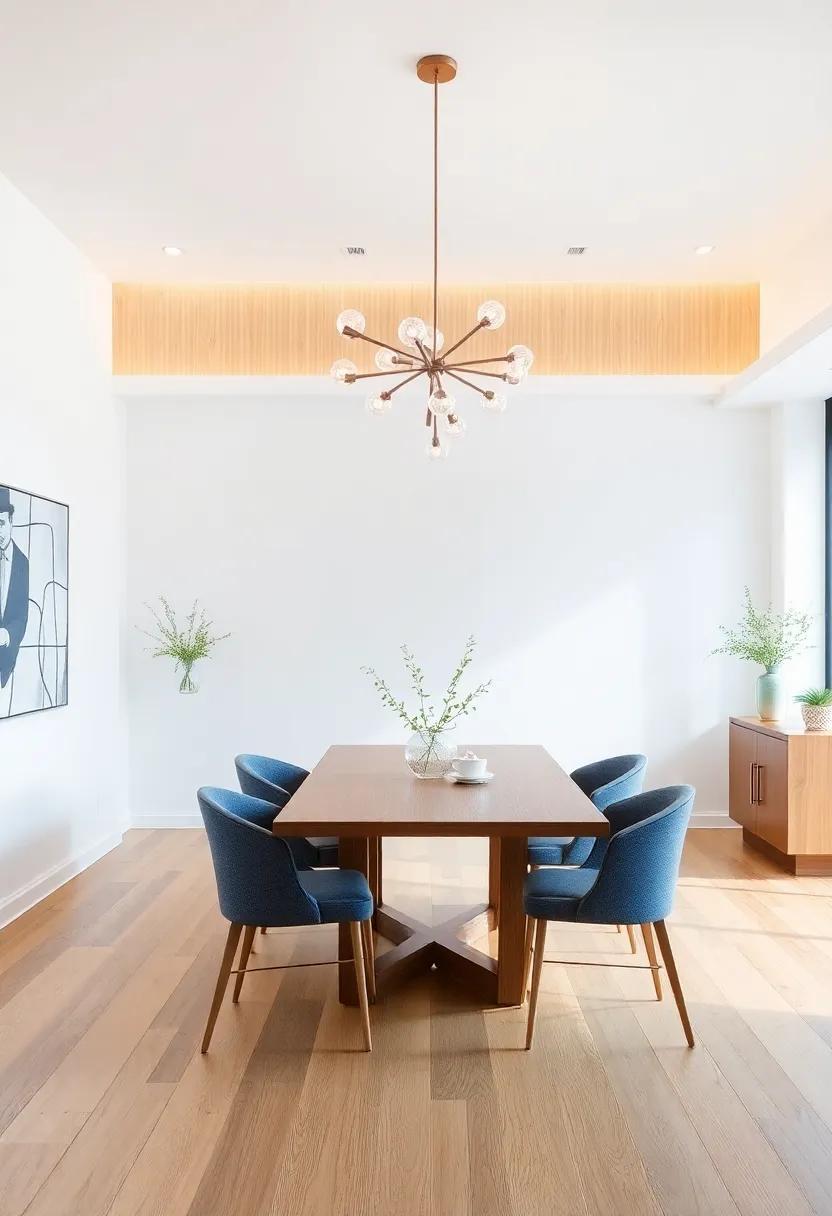
Exploring Open Concept Dining Room Designs: Spaces that Bring Life Together
In the heart of every home lies a space that transcends mere functionality—a place where meals are shared, conversations flow, and memories are made. Open concept dining rooms have emerged as a design trend that not only embraces adaptability but also fosters a sense of connection among family and friends.By tearing down customary barriers, these dynamic spaces invite light, inspire creativity, and create an atmosphere of togetherness. in this exploration of open concept dining room designs, we’ll delve into the thoughtful elements that transform a simple dining area into a vibrant hub of activity, highlighting innovative ideas, practical tips, and design inspirations that harmoniously blend style with the spirit of community. Join us as we uncover how these inviting environments can breathe life into your home and elevate the art of gathering.
Exploring the Concept of Open Concept Dining Room design for Modern Living

Open concept dining room design is more than just a trend; it’s a lifestyle choice that embraces connectivity and fluidity. By removing barriers between spaces, these designs create a warm and inviting atmosphere, allowing family and friends to engage in lively conversations while enjoying a meal.Imagine hosting an intimate dinner party where the host can effortlessly transition from the kitchen to the dining area without missing a beat. The open layout enhances interaction and makes the flow of movement effortless. Key elements that contribute to a prosperous open concept dining space include:
- Unified Color Schemes: Choosing a cohesive palette can harmoniously blend different areas.
- Multi-functional Furniture: Opt for tables that can expand for larger gatherings.
- strategic Lighting: layered lighting can define the dining area while keeping the ambiance inviting.
Maximizing the potential of your open dining experiance involves not just aesthetics but also functionality. Consider incorporating design features that enhance both style and usability.As a notable example, incorporating a central island with seating can serve as a culinary hub while also offering casual dining. Accessories and decorative elements shoudl reflect personal tastes, ensuring the space feels uniquely yours. A side table or a charming bar cart can effortlessly elevate your dining experience, making it both practical and visually appealing.Additionally, explore the following table for ideas on integrating elements that enhance your dining room:
| element | Benefit |
|---|---|
| Open Shelving | Displays dining ware and adds visual interest. |
| Seamless Floors | Creates an illusion of more space while enhancing flow. |
| Accent Walls | Adds depth and personality to the dining area. |
The harmony of Space: How Open Concept Designs enhance Social Interactions
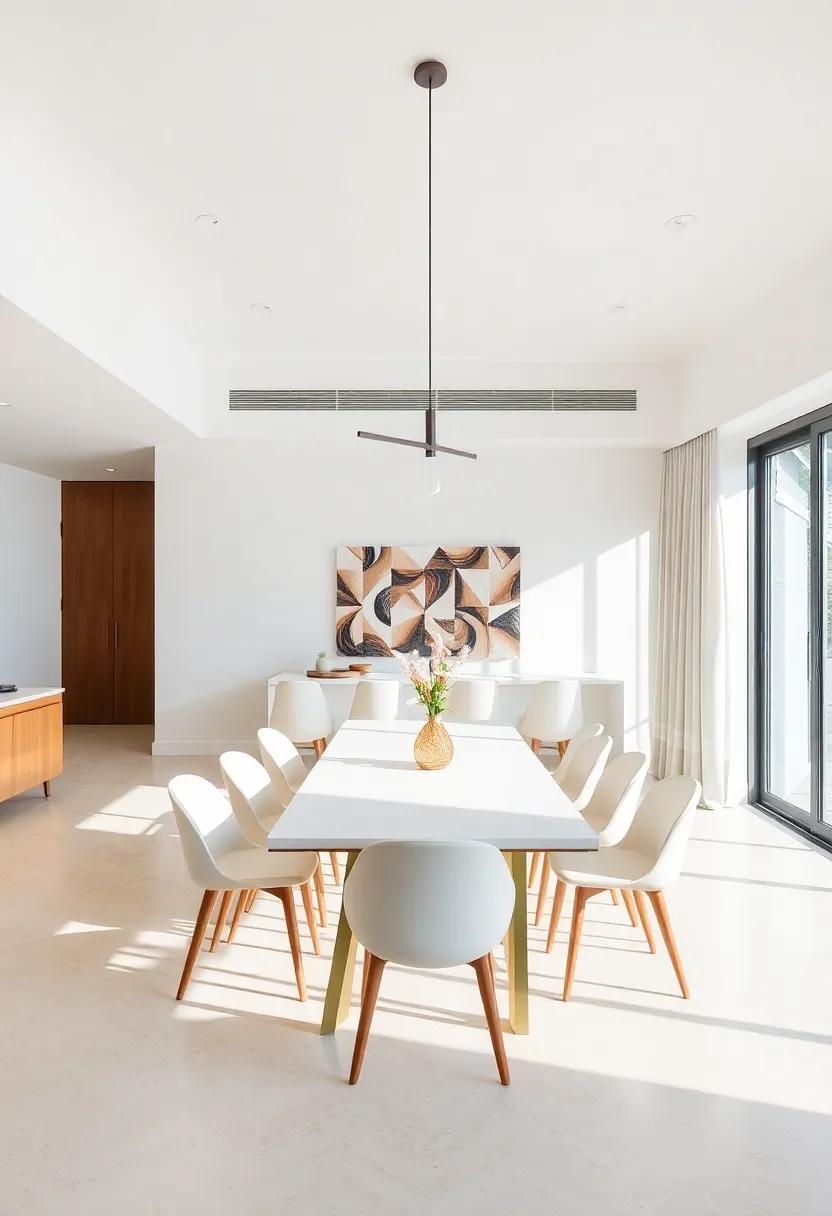
Open concept designs transform traditional dining experiences into vibrant gatherings by seamlessly blending living spaces. This fluidity not only promotes visual continuity but also enhances communication among guests. When friends and family gather around the table, they bask in the intimate atmosphere fostered by the surrounding openness. Key features that contribute to this synergy include:
- Natural Light: Expansive windows and minimal barriers invite sunlight, creating a warm and inviting ambiance.
- Flexible Furniture: Movable seating arrangements allow for easy reconfiguration, accommodating everything from quiet dinners to lively celebrations.
- Unified Color Schemes: Harmonious color palettes throughout the space encourage a sense of cohesion, enhancing the overall experience.
Moreover, open concept dining rooms encourage a participatory habitat where culinary creations can become the centerpiece of social interaction. With kitchens flowing into dining areas, hosts can engage with their guests while preparing meals, turning cooking into a shared experience. This connectivity is further enriched by:
| Element | Impact on Social Interaction |
|---|---|
| Layout | Facilitates movement and conversation between spaces. |
| Decor | Establishes a welcoming atmosphere that invites relaxation. |
| Technology | Connects different areas thru devices, allowing for entertainment and information sharing. |
Natural light and Its Impact: Designing Open Dining areas with Windows in Mind
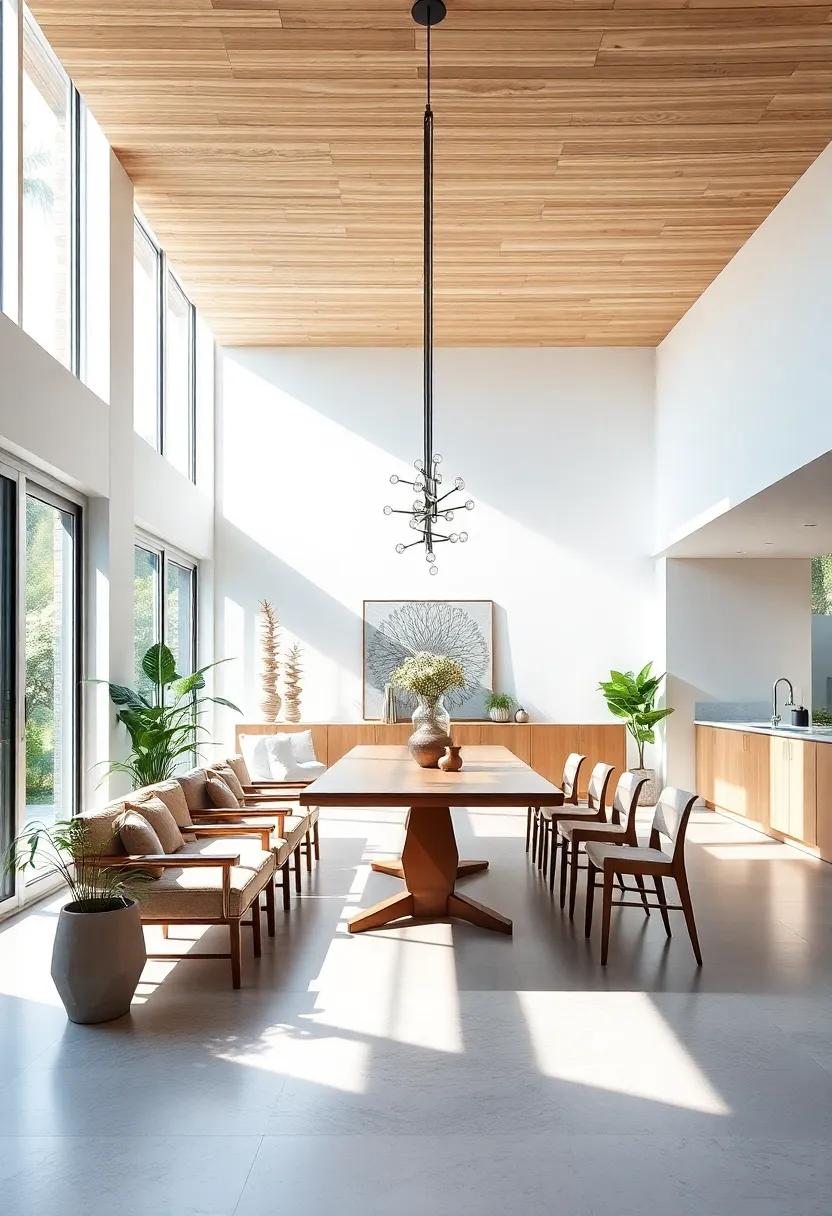
Incorporating natural light into open dining areas dramatically enhances the ambiance, fostering a sense of warmth and connection.Large windows or glass doors that invite sunlight can transform the space, making it feel more expansive and alive. This shining, cheerful environment not only uplifts the mood but also encourages social interactions, as family and friends gather around the table under the glow of daylight. When designing these spaces, consider the following elements to maximize the effect of natural light:
- Window Placement: Position windows to capture the best light throughout the day, ensuring they don’t create glare during mealtimes.
- Translucent Materials: Use sheer drapes or other lightweight materials that allow light to filter in while preserving privacy.
- Outdoor Views: Frame nature as a living artwork by orienting your dining area towards beautiful landscapes or gardens.
Additionally, the choice of color and decor can further enhance the natural light in your dining area. Light, airy palettes can reflect sunlight, thus amplifying the brightness within the space. In this very way, incorporating elements like white or pastel-colored walls, light wood furniture, and reflective materials can create an inviting atmosphere. Here’s a simple table showcasing popular color choices and their effects:
| Color | Effect on Space |
|---|---|
| White | Brightens and enlarges the space, creating a clean look. |
| Soft Pastels | Adds warmth while still reflecting light, creating a cozy feel. |
| Light grays | Offers a modern aesthetic while maintaining an airy atmosphere. |
Blending Styles: Incorporating Eclectic Elements in Open Dining Rooms

In the quest to design an inviting open dining room, blending styles can considerably enhance the overall atmosphere. Incorporating eclectic elements allows homeowners to weave personal stories into their space, creating a unique visual narrative. Here are several ways to achieve that charming fusion:
- Mixing Material textures: Combine wood, metal, and textiles. A rustic wood dining table paired with modern metal chairs can strike a beautiful balance.
- Cultural accents: Use decor pieces from different cultures—like Moroccan lanterns or Scandinavian ceramics—to add intrigue and personality.
- Artistic Touches: Hang eclectic artwork that reflects diverse styles,from abstract to traditional,to create a focal point that sparks conversation.
Another effective approach is through color and pattern play, which can unify disparate styles while still allowing individuality to shine. Consider the following elements when choosing your palate:
| Color Palette | Recommended Patterns |
|---|---|
| Earth Tones | Geometric and stripes |
| Bold Jewel Tones | Floral and Paisley |
| Soft Pastels | Polka Dots and checks |
By thoughtfully weaving together these elements, you can create an open dining room that not only looks harmonious but also tells a cohesive story reflective of your unique tastes.
Color Schemes that Connect: Choosing Palettes for Open Concept Dining Spaces
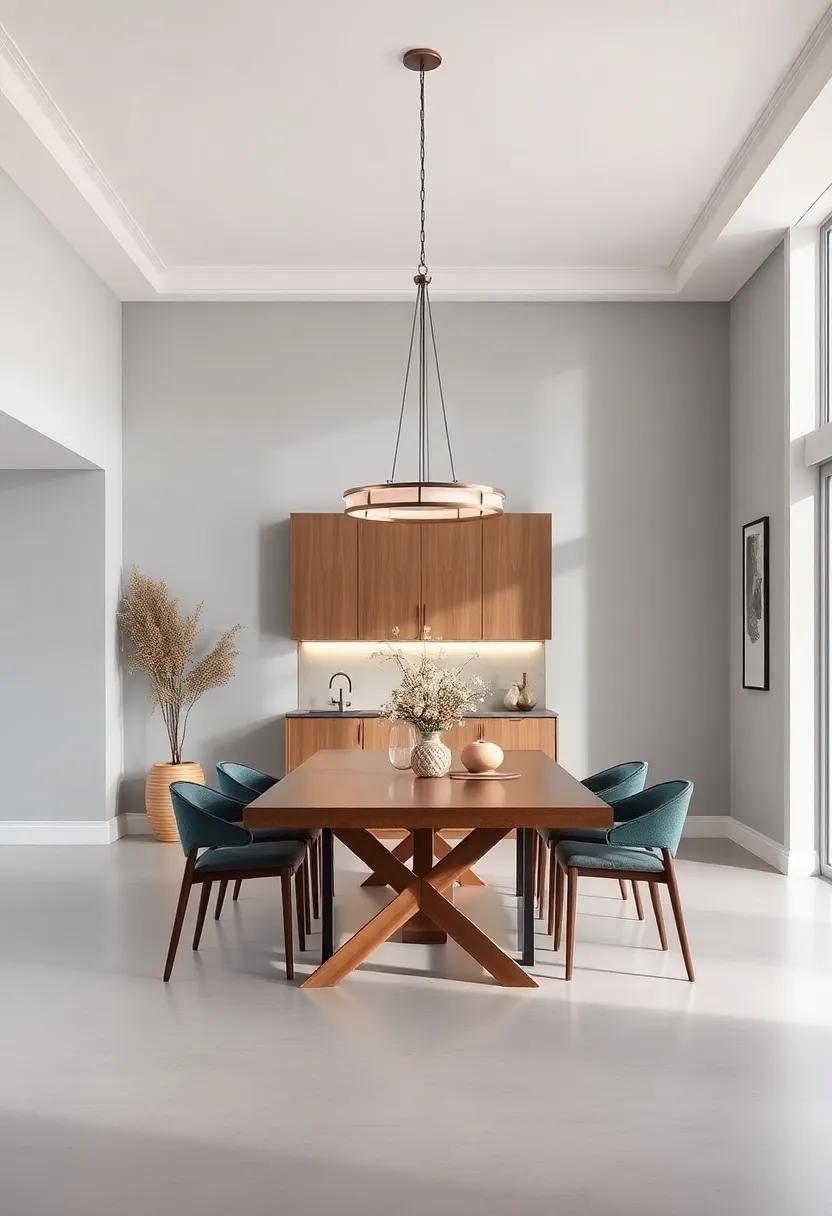
In open concept dining spaces, the right palette creates a seamless flow between areas, fostering unity and warmth. Neutral tones such as beige, soft grays, and whites can serve as the perfect backdrop, allowing for accents to shine through without overwhelming the eye. Pairing these with earthy hues like terracotta or muted greens can introduce a touch of nature, making your dining experience feel organic and inviting. Consider incorporating bold accent colors through décor elements, like vibrant table settings or wall art, which can punctuate the space with personality while maintaining a cohesive look.
To maximize the harmony of your environment, leverage the concept of color blocking to create defined areas within the open layout. start with a base color that harmonizes across the dining and adjacent spaces. Utilize a combination of complementary and analogous colors to achieve depth and visual interest. A table showcasing how various colors interact can assist in visualizing your choices:
| Color Group | Base Color | Accent 1 | Accent 2 |
|---|---|---|---|
| Neutral and Earthy | Soft Beige | Muted Green | Terracotta |
| Bold and Bright | White | Deep Blue | Bright Yellow |
| Warm and Inviting | Gray | Burnt Orange | Soft Amber |
Furniture Arrangement strategies for Maximizing Flow in Dining Areas

Effective furniture arrangement is essential for cultivating a vibrant dining area that encourages conversation and connection. to achieve an inviting flow,consider the following strategies:
- Central Focal Point: Arrange the dining table as the centerpiece,allowing ample space for movement around it.
- Defined Zones: Create distinct areas for dining, socializing, and serving, ensuring easy transitions between them.
- Seating Options: Offer a mix of chairs and benches to create dynamic seating arrangements that accommodate various group sizes.
- Pathways: Maintain clear pathways of at least 30 inches wide to encourage easy access to seating and service areas.
Incorporating these principles can transform your dining area into a place where energy flows freely, enhancing the overall experience. Additionally, consider using multi-functional furniture to maximize space efficiency:
| Furniture Type | Functionality |
|---|---|
| Extendable Table | Accommodates varying guest counts with space-saving design. |
| Storage Benches | Provides seating while offering concealed storage for dining essentials. |
| Rolling Carts | Facilitates smooth serving and easy access to beverages or snacks. |
Creating Zones within Open Spaces: Defining Dining Areas Through Design
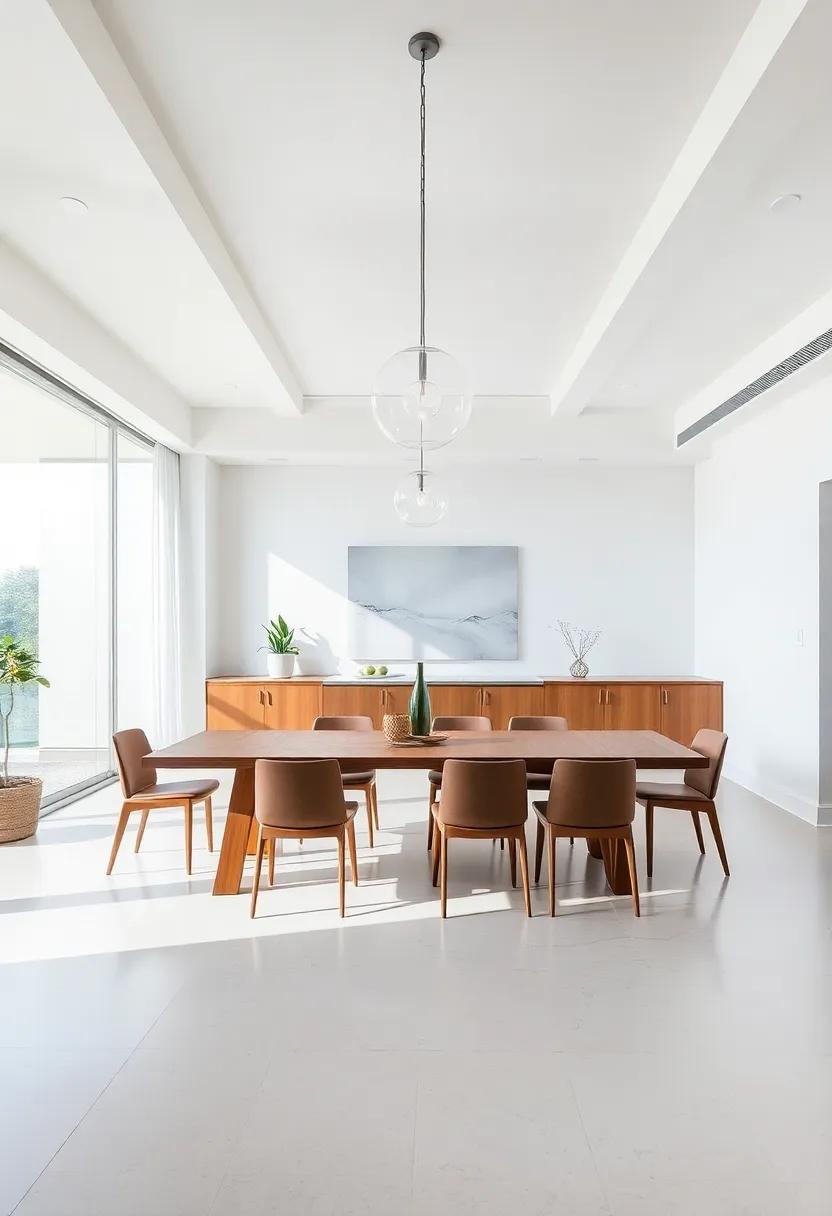
Creating distinct dining zones within open spaces not only enhances functionality but also establishes a vibrant atmosphere for gatherings. Strategic placement of furniture and design elements can effectively signal a dining area without the need for walls. consider the following design strategies:
- Area Rugs: Use a large area rug to delineate the dining space, adding visual warmth and comfort.
- Lighting Fixtures: hang a statement chandelier or pendant lights above the dining table to create a focal point and draw attention to the dining zone.
- Divider Elements: Implement open shelving or decorative screens to subtly separate the dining area from the rest of the space while maintaining an airy feel.
Incorporating these design elements allows for an immersive dining experience that celebrates togetherness. For a more tailored approach, consider these key dimensions that influence the overall design of the dining area:
| Element | Suggested Dimension |
|---|---|
| dining Table Diameter | 48-60 inches |
| clearance Around Table | 36-48 inches |
| ceiling Height | Minimum 8 feet |
The Role of Textures: Layering Fabrics to Enrich Open Concept Dining Rooms

In an open concept dining room, layering fabrics effectively introduces a tactile dimension that can significantly elevate the space. By combining different textures, such as soft linens, silky velvets, and rustic wools, you create an intriguing visual contrast that draws the eye. Incorporating elements like plush table runners,textured placemats,or even upholstered chairs can provide depth and create an inviting atmosphere. Consider the harmony of colors when selecting these fabrics; earth tones paired with subtle patterns can help tie the dining area to other open spaces, enhancing the overall flow of the design.
To strategically layer fabrics, keep in mind the key components of your dining room’s aesthetics. Here are some elements to consider:
- Table Linens: Opt for varying textures that complement your tabletop.
- Seat Cushions: Mix and match upholstery to create a dynamic seating area.
- Wall Hangings: Use textured wall art or fabric panels to add dimension.
- Window Treatments: Layer curtains or shades to create light and shadow play.
Furthermore, integrating a texture palette can simplify your choices and ensure cohesive design. Here’s a concise example of how different textures can interact:
| Texture | Effect | Recommended Usage |
|---|---|---|
| Silk | Luxurious feel | Table runners & curtains |
| Jute | Natural warmth | Rug & placemats |
| Linen | Relaxed elegance | Napkins & chair cushions |
| Velvet | Soft richness | Upholstered chairs & pillows |
Integrated Kitchen and Dining: The Seamless Transition Between Culinary and Social Spaces

In modern homes, the boundaries between cooking and dining are increasingly blurred, creating spaces that encourage interaction and connection. An integrated kitchen and dining area not only optimizes functionality but also fosters a warm atmosphere where family and friends can gather. Key elements to consider in this design approach include:
- Open Layouts: Removing walls cultivates a sense of spaciousness and continuity, allowing natural light to flow freely throughout the area.
- Multipurpose Furniture: Incorporating versatile pieces,such as kitchen islands that double as dining tables,enhances usability and seating options.
- Color and Material Harmony: Selecting a cohesive color palette and complementary materials can create a seamless visual transition between the kitchen and dining zones.
To further encourage social interactions, consider adding elements that invite engagement, such as an inviting breakfast nook or a bar-height countertop that lets guests participate in the cooking process. For those who love to entertain, integrating technology can elevate the experience, making it easier to prepare meals while engaging with guests. Some innovative approaches include:
| Feature | Benefits |
|---|---|
| smart Appliances | Enhance efficiency; controlled via app for multitasking. |
| Sliding Glass Doors | Provides easy access to outdoor spaces for al fresco dining. |
| Integrated Lighting | Sets the mood; adjustable from bright to soft ambiance. |
Artistry in Dining: Using wall Art to Bring personality to Open Concept Areas

In open concept dining areas, wall art acts as a vivid storytelling medium, weaving together visual narratives that resonate with your personal style. A carefully curated selection of pieces can transform bare walls into captivating backdrops that invite conversation and connection. When choosing artwork, consider the following elements to enhance your space:
- Color Palette: Opt for art that complements the hues of your dining furniture and decor.
- Scale and Size: Mix large statement pieces with smaller artworks to create an engaging visual rhythm.
- Theme Cohesion: Choose artworks that reflect a common theme or style, such as minimalist, abstract, or vintage.
Along with individual pieces, creating a cohesive gallery wall can add depth and personality to your dining experience.This engaging arrangement allows for flexibility and creativity, enabling you to swap out pieces as your tastes evolve. Consider the following tips for your gallery wall:
| Tip | Clarification |
|---|---|
| Stay Grounded | Let the dining table be your focal point; arrange art to draw the eye towards it. |
| Use Varied Frames | Mix different frame styles to create an eclectic yet cohesive look. |
| Incorporate Natural Elements | pair wall art with plants for a fresh,organic feel that links the indoors with nature. |
Catering to Different Occasions: Flexible Furniture for Varied Dining Experiences
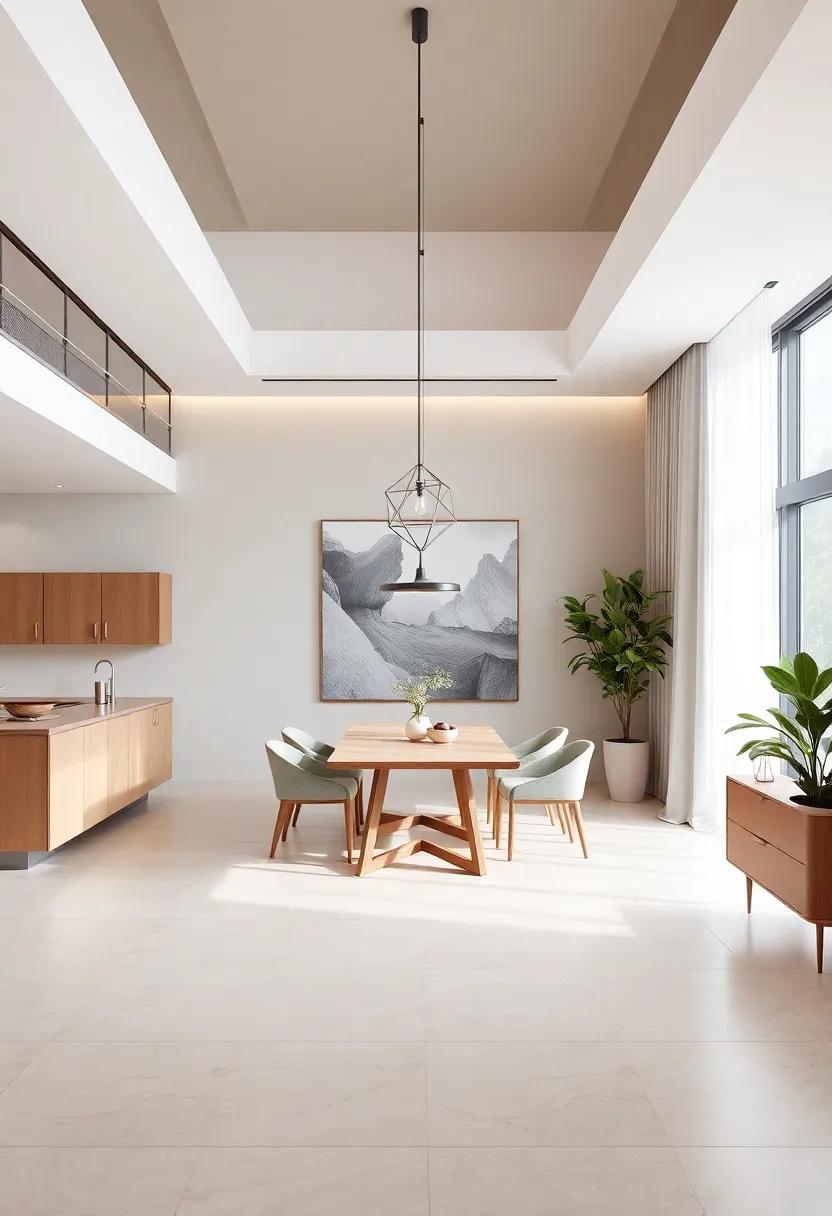
Creating a dynamic dining environment means embracing furniture that adapts to various occasions.An open concept space thrives on the ability to transform, making it essential to select pieces that can adjust to both intimate family dinners and larger gatherings. Consider options like extendable tables that can accommodate additional guests or modular seating arrangements that offer flexibility in configuration. By investing in furniture that can be reconfigured easily, you allow for spontaneous gatherings without the constraints of traditional layouts.
think about incorporating elements that encourage social interaction and maximize comfort. Options such as bistro tables for casual brunches or even outdoor seating for al fresco dining can create varied dining experiences. The right lighting also plays a crucial role; pendant lights can establish an inviting atmosphere for formal dinners, while string lights lend a cozy feel for relaxed evenings. With thoughtful selections, the dining area not only serves meals but also becomes a hub for cherished memories.
Incorporating Nature: Biophilic Design Elements in Open Concept Dining Areas

Embracing biophilic design elements can transform open-concept dining areas into serene havens that foster connection with nature. Incorporating features like large windows and skylights not only floods the space with natural light but also offers unobstructed views of the outdoor environment.Natural materials such as wood, stone, and plants can further enhance this connection. Consider integrating features such as:
- Hanging planters that bring greenery down from above
- Indoor herb gardens on windowsills for accessibility and fragrance
- Water elements like small fountains that add tranquility and soothing sounds
Another effective way to celebrate the natural world is through color palettes inspired by nature. Earthy tones and soft greens not only complement the dining area but also evoke a sense of calm and relaxation. Additionally, furniture can be designed to mimic organic shapes, blurring the lines between the indoors and outdoors. A well-planned dining area can include a minimalistic dining table crafted from reclaimed wood, paired with chairs that feature natural fibers. Furthermore, light fixtures resembling tree branches or glowing orbs can serve as artistic focal points. Below is a simple table illustrating a few design elements and their benefits:
| Design Element | Benefit |
|---|---|
| large Windows | Maximizes natural light and views |
| Indoor Plants | Improves air quality and adds color |
| Natural Textures | Creates a warm and inviting atmosphere |
| Earth Tones | Promotes relaxation and peace |
Lighting the Way: Selecting Fixtures to Illuminate Open Dining Spaces
Choosing the perfect fixtures for an open dining space is essential to achieving a harmonious balance between functionality and aesthetics. Goal-oriented lighting not only enhances the beauty of your dining area but also defines the ambiance. Consider a mix of pendant lights, chandeliers, and wall sconces to create a layered look that invites conversation and engagement. Each type of fixture serves a purpose: pendants offer task lighting over a dining table, while chandeliers add a touch of elegance and can serve as a statement piece. Wall sconces can frame the space beautifully and provide ambient light that softens the room’s atmosphere.
When selecting these fixtures, think about the scale and style of your space. Ensure your choices complement your existing décor while also providing adequate illumination. It’s important to balance brightness with warmth, so consider LED bulbs that mimic natural light for an inviting glow. Below is a simple table showcasing some popular fixture styles and their features:
| Fixture Type | Key Features |
|---|---|
| Pendant Lights | Direct Lighting, Versatile Styles |
| Chandeliers | Statement Piece, Ambient and Task Lighting |
| Wall Sconces | Framing Effect, Soft Ambient Light |
Personal Touches: Curating Décor that reflects You in an Open Concept Setting

In an open concept dining room,where the lines between the kitchen,living area,and dining space blur,personal touches are essential to create a cohesive atmosphere that truly reflects your identity. incorporate art pieces that hold sentimental value or represent your travels; whether it’s a vibrant painting, a unique ceramic piece, or framed photographs, these accents can become focal points that spark conversation. Additionally, layering textures through fabric choices can further enhance the ambiance. Think of table runners, plush cushions on seating, and woven placemats that add depth and warmth to the room.
Another way to infuse personality into your décor is by selecting a curated color palette that resonates with your style. Consider the following elements:
- Accent Walls: Use paint or wallpaper to create a striking backdrop for your dining area.
- Statement Lighting: Choose a sculptural chandelier or eclectic pendant lights that serve as both functional and decorative components.
- Herb or Plant Displays: Integrate greenery that complements the dining aesthetic while adding a touch of nature and vibrancy.
Combining these features with a well-planned layout fosters an inviting space that promotes connection and engagement among family and guests. Here’s a simple visualization of various styles you can incorporate:
| Style | Description |
|---|---|
| Modern Minimalist | Clean lines, neutral colors, and functional furnishings. |
| Rustic Charm | Natural materials, warm tones, and vintage accents. |
| Eclectic Mix | Layered patterns, unexpected colors, and eclectic furnishings. |
| Coastal Vibes | Soft blues, whites, and nautical decorations that evoke the beach. |
The Sound of Togetherness: designing Acoustic Elements for Open Dining Areas

In an open dining area,the ambiance sets the stage for connections,and acoustic elements play a pivotal role in crafting the desired atmosphere. Thoughtfully designed soundscapes can enhance conversation and elevate the dining experience, making it vital to consider various acoustic elements. Incorporating elements such as soft furnishings, acoustic panels, and strategic layout can greatly influence how sound travels throughout the space:
- Soft Furnishings: Cushioned chairs, plush rugs, and thick drapery absorb sound and reduce echo.
- Acoustic Panels: Decorative acoustic tiles can be artfully integrated into the design, serving both aesthetic and functional purposes.
- Strategic Layout: Arranging furniture to create natural barriers, like plant walls or bookcases, can definitely help delineate spaces while optimizing sound absorption.
Furthermore, selecting materials wisely can further enhance acoustics in a communal setting. Choosing the right flooring, ceiling, and wall finishes is essential for sound management. Here’s a simple comparison of material options:
| Material Type | Sound Absorption | Visual Appeal |
|---|---|---|
| Carpet | High | warm and Cozy |
| Hardwood | Medium | Timeless elegance |
| Acoustic Tiles | Very High | Contemporary Designs |
Ultimately, by harmonizing these design elements, you can create inviting and engaging open dining spaces that resonate with warmth and foster a sense of community.
Inviting the Outdoors In: How to Utilize Outdoor Views for Dining Inspiration
Incorporating outdoor views into your dining space can transform it into a vibrant sanctuary where nature and culinary art converge. To maximize this connection, consider using large windows or sliding glass doors that seamlessly blend your interior with the outdoor landscape. When designing your dining area, opt for color palettes that mirror the hues found outside; earthy greens, soft browns, and sky blues can help create a cohesive look.other ideas include:
- Extend your tabletop: utilize a table made of natural materials like reclaimed wood or stone to echo the surroundings.
- Use natural light: Position your dining table near windows to flood the space with sunlight, bringing warmth and life.
- Incorporate plants: Table centerpieces or wall decor featuring greenery can bring the essence of nature indoors.
Adding to this theme, it’s essential to consider how the outdoor ambiance can dictate your dining experience. A view of a garden or water feature can set a calming tone, making meals more enjoyable for family and guests alike. Utilizing elements like textures and lighting can further enhance this experience. As an example, soft textiles in the dining area, such as linen or cotton tablecloths and cushions, can provide a cozy atmosphere, while varying light sources—like pendant lights or candles—can evoke the rhythm of a sunset. Below is a simple guide to complement your outdoor views:
| Element | Outdoor Inspiration |
|---|---|
| Color Palette | Nature-inspired greens and blues |
| Materials | Natural woods and stones |
| Light | Natural and warm lighting |
| Textures | Soft textiles and organic shapes |
Innovative Storage Solutions: Clever ways to Organize in Open Dining Concepts

In open dining concepts, where space often flows seamlessly into living areas, efficient storage solutions are essential for maintaining order and functionality. By integrating multifunctional furniture that merges style with practicality,you can create spaces that serve multiple purposes without overwhelming the visual landscape.Consider a dining table that features hidden storage compartments for linens, utensils, and placemats, or benches with space underneath for stowing away items.Utilizing vertical space with wall-mounted shelves not only enhances storage but also allows for the personal expression of decor, showcasing items like dishes or decorative plants that can double as conversation starters.
Another clever way to maximize storage while enhancing the overall aesthetic is through the use of cabinets with glass fronts that display your finest dinnerware.This approach not only provides easy access but also keeps items visible, promoting a sense of cohesion within the open space. Additionally,consider integrating small mobile carts that can be easily moved alongside furniture; they can hold beverages or serve as a mini buffet during gatherings while maintaining a tidy appearance when not in use. The versatility of these solutions ensures that the dining experience remains both inviting and organized.
Celebrating Seasonal Changes: Adapting your Open Dining Design Throughout the Year
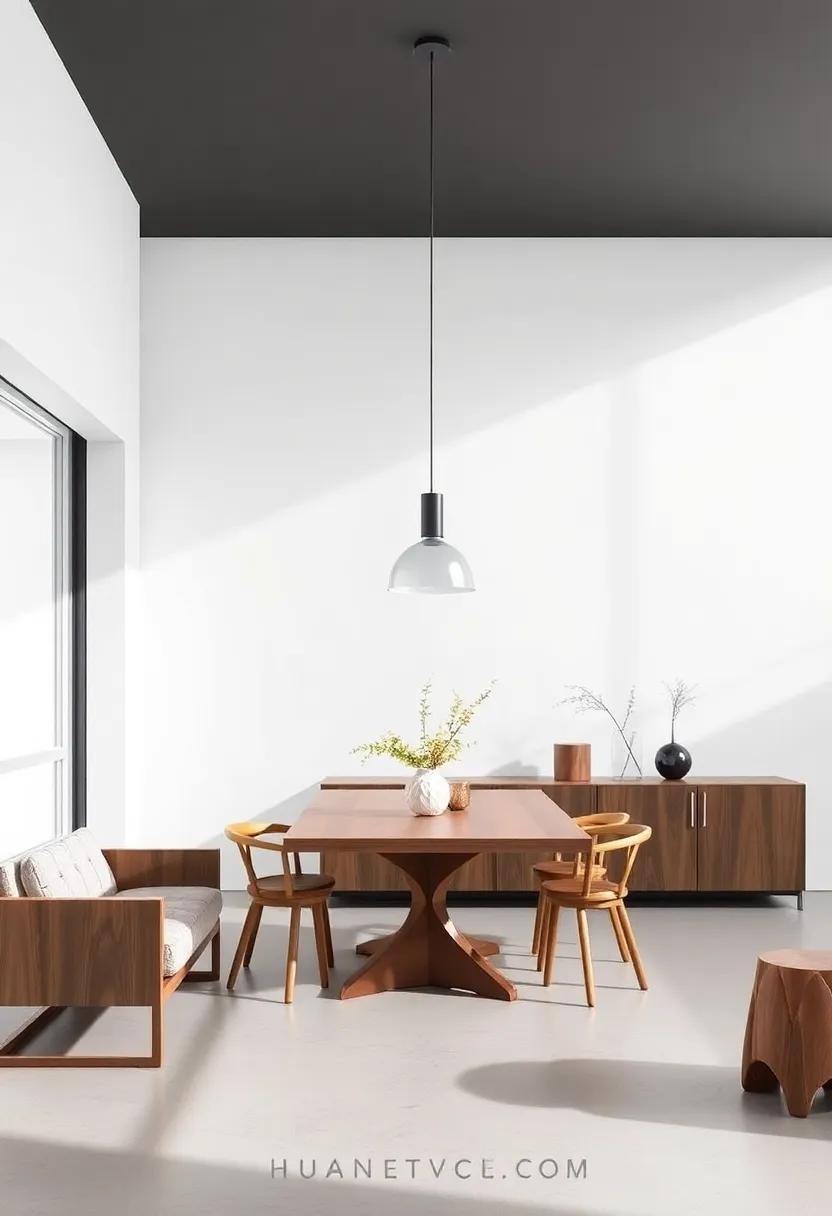
As the seasons shift, so does the mood and atmosphere in your open dining space.Embrace the beauty of each season by adapting your decor and color palette to reflect the natural changes around you. In spring, consider incorporating soft pastels and floral motifs to breathe fresh life into the room. As summer approaches, vibrant colors and lightweight textiles create a cheerful ambiance, perfect for those leisurely al fresco meals. Autumn brings a warm palette of oranges, browns, and deep reds, inviting cozy gatherings, while winter can be adorned with rich jewel tones and the glimmer of soft lighting for a festive touch.
To make these transitions seamless, consider adding versatile elements to your design. Here are a few ideas to enhance your open dining area throughout the year:
- Seasonal Centerpieces: Rotate fresh flowers or natural elements like pinecones and leaves.
- Textile Changes: Swap out table runners, cushions, and curtains reflecting seasonal colors.
- Lighting Adjustments: Use dimmers or fairy lights for a cozy feel in colder months.
- Tableware Variations: Introduce themed plates, glasses, and utensils that match the season’s vibe.
| Season | Color palette | Decor Ideas |
|---|---|---|
| Spring | Pastels | Flower vases,light linens |
| Summer | bright Colors | Outdoor accessories,vibrant dishware |
| Autumn | Warm Tones | Harvest decorations,candle arrangements |
| Winter | Jewel Tones | Festive lights,cozy textiles |
Sustainable Choices: Eco-Friendly Materials for Open Concept Dining Rooms

Choosing eco-friendly materials for your open concept dining room not only enhances the aesthetic appeal but also contributes to a healthier planet.Incorporating sustainable materials is essential for creating a space that harmonizes with nature. Consider these popular options:
- Bamboo: Rapidly renewable and incredibly durable, this material offers a beautiful look while being environmentally friendly.
- Reclaimed Wood: Using repurposed wood minimizes waste and adds character to your dining area, with unique textures and stories behind each piece.
- Recycled Glass: Ideal for tabletops or decorative accents,recycled glass brings elegance and sustainability together.
- Cork: Its natural insulation properties make cork a practical choice for flooring while being harvested without harming trees.
Additionally, making responsible choices in textiles and finishes can amplify your dining room’s eco-conscious design. Select materials that are non-toxic and sustainably sourced, such as:
- Organic Cotton: Perfect for table linens, seat cushions, and curtains, organic cotton is grown without harmful pesticides.
- Water-Based Finishes: These finishes reduce harmful emissions, ensuring a safer environment during and after submission.
- Natural Stone: Durable and timeless, natural stone components can be used for countertops or accent walls, offering a low-impact option.
Wrapping Up
As we conclude our journey through the vibrant world of open concept dining room designs, it’s clear that these spaces do more than just merge rooms; they forge connections. Each layout reveals a unique story, where the kitchen’s warmth flows seamlessly into the dining area’s inviting ambiance, creating a harmonious backdrop for gatherings, conversations, and shared meals.
Whether you favor minimalist aesthetics or lush, eclectic styles, the essence of an open concept is adaptability, allowing each individual to imprint their personality onto the space. As you envision your ideal dining area, remember that it’s not just about the furniture or decor, but about the life and memories that will flourish within those walls.
With an open heart and an open layout, your dining room can become a canvas for life’s most cherished moments. So, go forth and design with intention, creating an atmosphere that not only reflects your taste but also invites warmth and togetherness into your home. Here’s to many beautiful dinners, laughter-filled gatherings, and cherished memories in your new open concept dining space!
As an Amazon Associate I earn from qualifying purchases.
